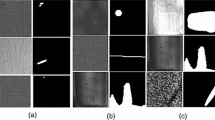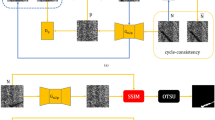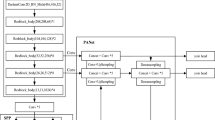Abstract
This paper introduces an approach for the segmentation of surface defects, referred to as Efficient Surface Defect Network (ESD-Net). The proposed method uses novel components called the GhostNet Fusion Block (GFB) and the Global Auxiliary Layer (GAL) to make it edge computing-ready and to increase its performance on segmentation. The GFB algorithm employs a technique whereby it conserves and combines feature maps of reduced resolution from the original image with feature maps that have been downsampled at various resolutions. Moreover, the GAL amplifies the GFB by including comprehensive contextual information from a global perspective. The experiment shows that the proposed method outperforms state-of-the-art algorithms on SD-saliency-900, MSD, and Magnetic-tile, three public surface defect datasets with mIoU of \(82.4\%\), \(92.9\%\), and \(78.8\%\), respectively. Embedded device experiments have proven that ESDNet can be utilized on a wider range of cost-effective industrial devices with acceptable latency.








Similar content being viewed by others
References
Zheng, Z., Hu, Y., Zhang, Y., Yang, H., Qiao, Y., Qu, Z., Huang, Y.: Casppnet: a chained atrous spatial pyramid pooling network for steel defect detection. Meas. Sci. Technol. 33(8), 085403 (2022). https://doi.org/10.1088/1361-6501/ac68d2
Tang, B., Chen, L., Sun, W., Lin, Z.K.: Review of surface defect detection of steel products based on machine vision. IET Image Process. 17(2), 303–322 (2023). https://doi.org/10.1049/ipr2.12647
Liu, G.: Surface defect detection methods based on deep learning: a brief review. In: 2020 2nd International Conference on Information Technology and Computer Application (ITCA), (2020). pp. 200–203 (2020). https://doi.org/10.1109/ITCA52113.2020.00049
Poxi, H., Chen, W., Gao, J.: Overview of surface defect detection methods based on deep learning. In: Wang, Y., Yu, T., Wang, K. (eds) Advanced Manufacturing and Automation XII, (2023). pp. 123–128 (2023)
Minaee, S., Boykov, Y., Porikli, F., Plaza, A., Kehtarnavaz, N., Terzopoulos, D.: Image segmentation using deep learning: a survey. IEEE Trans. Pattern Anal. Mach. Intell. 44(7), 3523–3542 (2022). https://doi.org/10.1109/TPAMI.2021.3059968
Bao, Y., Song, K., Liu, J., Wang, Y., Yan, Y., Yu, H., Li, X.: Triplet-graph reasoning network for few-shot metal generic surface defect segmentation. IEEE Trans. Instrum. Meas. 70, 1–11 (2021). https://doi.org/10.1109/TIM.2021.3083561
Lu, P., Jing, J., Huang, Y.: Mrd-net: an effective cnn-based segmentation network for surface defect detection. IEEE Trans. Instrum. Meas. 71, 1–12 (2022). https://doi.org/10.1109/TIM.2022.3200361
Liu, T., He, Z., Lin, Z., Cao, G.Z., Su, W., Xie, S.: An adaptive image segmentation network for surface defect detection. IEEE Trans. Neural Netw. Learn. Syst. (2022). https://doi.org/10.1109/TNNLS.2022.3230426
Cao, J., Yang, G., Yang, X.: A pixel-level segmentation convolutional neural network based on deep feature fusion for surface defect detection. IEEE Trans. Instrum. Meas. 70, 1–12 (2021). https://doi.org/10.1109/TIM.2020.3033726
Han, K., Wang, Y., Tian, Q., Guo, J., Xu, C., Xu, C.: Ghostnet: more features from cheap operations. In: 2020 IEEE/CVF Conference on Computer Vision and Pattern Recognition (CVPR) (2020). pp. 1577–1586 (2020). https://doi.org/10.1109/CVPR42600.2020.00165
Wang, L., Huang, X., Zheng, Z., Ruan, H.: Surface defect detection method for electronic panels based on double branching and decoupling head structure. PLoS One 18(2), 1–19 (2023). https://doi.org/10.1371/journal.pone.0279035
Mehta, S., Rastegari, M., Caspi, A., Shapiro, L., Hajishirzi, H.: Espnet: efficient spatial pyramid of dilated convolutions for semantic segmentation. In: Computer Vision - ECCV 2018: 15th European Conference, Munich, Germany, September 8-14, 2018, Proceedings, Part X. Springer-Verlag, pp. 561–580 (2018). https://doi.org/10.1007/978-3-030-01249-6_34
Zhang, W., Ding, X., Liu, Y., Qiao, B.: Slide deep reinforcement learning networks: application for left ventricle segmentation. Pattern Recogn. 141, 109667 (2023). https://doi.org/10.1016/j.patcog.2023.109667
Vigneault, D.M., Xie, W., Ho, C.Y., Bluemke, D.A., Noble, J.A.: Omega-net: fully automatic, multi-view cardiac mr detection, orientation, and segmentation with deep neural networks. Med. Image Anal. 48, 95–106 (2018). https://doi.org/10.1016/j.media.2018.05.008
Yu, C., Wang, J., Peng, C., Gao, C., Yu, G., Sang, N.: Bisenet: Bilateral segmentation network for real-time semantic segmentation. In: Computer Vision – ECCV 2018. Springer International Publishing, pp. 334–349 (2018)
Zhao, H., Qi, X., Shen, X., Shi, J., Jia, J.: Icnet for real-time semantic segmentation on high-resolution images. In: Computer Vision – ECCV 2018. Springer International Publishing, pp. 418–434 (2018)
Paszke, A., Chaurasia, A., Kim, S., Culurciello, E.: Enet: A deep neural network architecture for real-time semantic segmentation. ArXiv. arxiv:1606.02147 (2016)
Ioffe, S., Szegedy, C.: Batch normalization: Accelerating deep network training by reducing internal covariate shift. In: Proceedings of the 32nd International Conference on Machine Learning, Proceedings of Machine Learning Research, vol. 37. PMLR, pp. 448–456 (2015)
Hu, J., Shen, L., Sun, G.: Squeeze-and-excitation networks. In: 2018 IEEE/CVF Conference on Computer Vision and Pattern Recognition, (2018). pp. 7132–7141 (2018). https://doi.org/10.1109/CVPR.2018.00745
Ronneberger, O., Fischer, P., Brox, T.: U-net: Convolutional networks for biomedical image segmentation. In: Medical Image Computing and Computer-Assisted Intervention – MICCAI 2015. Springer International Publishing, pp. 234–241 (2015)
Zhu, W., Liang, R., Yang, J., Cao, Y., Fu, G., Cao, Y.: A sub-region unet for weak defects segmentation with global information and mask-aware loss. Eng. Appl. Artif. Intell. 122, 106011 (2023)
Song, G., Song, K., Yan, Y.: Saliency detection for strip steel surface defects using multiple constraints and improved texture features. Opt. Lasers Eng. 128, 106000 (2020)
Huang, Y., Qiu, C., Guo, Y., Wang, X., Yuan, K.: Surface defect saliency of magnetic tile. Vis. Comput. 36, 85–96 (2018)
Zhang, J., Ding, R., Ban, M., Guo, T.: Fdsnet: an accurate real-time surface defect segmentation network. In: ICASSP 2022 - 2022 IEEE International Conference on Acoustics, Speech and Signal Processing (ICASSP). pp. 3803–3807 (2022)
Shrivastava, A., Gupta, A., Girshick, R.: Training region-based object detectors with online hard example mining (2016)
Kingma, D., Ba, J.: Adam: A method for stochastic optimization. In: International Conference on Learning Representations (ICLR). San Diega, CA, USA, (2015)
Zhao, H., Shi, J., Qi, X., Wang, X., Jia, J.: Pyramid scene parsing network. In: 2017 IEEE Conference on Computer Vision and Pattern Recognition (CVPR). pp. 6230–6239 (2017). https://doi.org/10.1109/CVPR.2017.660
Paszke, A., Gross, S., Massa, F., Lerer, A., Bradbury, J., Chanan, G., Killeen, T., Lin, Z., Gimelshein, N., Antiga, L., Desmaison, A., Kopf, A., Yang, E., DeVito, Z., Raison, M., Tejani, A., Chilamkurthy, S., Steiner, B., Fang, L., Bai, J., Chintala, S.: In: Advances in Neural Information Processing Systems 3. Curran Associates, Inc., pp. 8024–8035 (2019)
Dong, H., Song, K., He, Y., Xu, J., Yan, Y., Meng, Q.: Pga-net: Pyramid feature fusion and global context attention network for automated surface defect detection. IEEE Trans. Industr. Inf. 16(12), 7448–7458 (2020). https://doi.org/10.1109/TII.2019.2958826
Chen, X., Fu, C., Tie, M., Sham, C.W., Ma, H.: Affnet: an attention-based feature-fused network for surface defect segmentation. Appl. Sci. (2023). https://doi.org/10.3390/app13116428
Long, J., Shelhamer, E., Darrell, T.: Fully convolutional networks for semantic segmentation. In: 2015 IEEE Conference on Computer Vision and Pattern Recognition (CVPR). pp. 3431–3440 (2015). https://doi.org/10.1109/CVPR.2015.7298965
Chen, L.C., Papandreou, G., Kokkinos, I., Murphy, K., Yuille, A.L.: Deeplab: semantic image segmentation with deep convolutional nets, atrous convolution, and fully connected crfs. IEEE Trans. Pattern Anal. Mach. Intell. 40(4), 834–848 (2018). https://doi.org/10.1109/TPAMI.2017.2699184
Qin, X., Zhang, Z., Huang, C., Dehghan, M., Zaiane, O.R., Jagersand, M.: U2-net: going deeper with nested u-structure for salient object detection. Pattern Recogn. 106, 107404 (2020)
Wang, Y., Zhou, Q., Liu, J., Xiong, J., Gao, G., Wu, X., Latecki, L.J.: Lednet: a lightweight encoder-decoder network for real-time semantic segmentation. In: 2019 IEEE International Conference on Image Processing (ICIP). pp. 1860–1864 (2019)
Poudel, R.P.K., Liwicki, S., Cipolla, R.: Fast-scnn: fast semantic segmentation network. In: 30th British Machine Vision Conference (2019)
Jiang, X., Wang, H., Chen, Y., Wu, Z., Wang, L., Zou, B., Yang, Y., Cui, Z., Cai, Y., Yu, T., Lv, C., Wu, Z.: Mnn: a universal and efficient inference engine. In: MLSys (2020)
Author information
Authors and Affiliations
Contributions
Igi Ardiyanto developed and implemented the algorithms for the work.
Corresponding author
Ethics declarations
Conflict of interest
The authors declare no competing interests.
Additional information
Publisher's Note
Springer Nature remains neutral with regard to jurisdictional claims in published maps and institutional affiliations.
Rights and permissions
Springer Nature or its licensor (e.g. a society or other partner) holds exclusive rights to this article under a publishing agreement with the author(s) or other rightsholder(s); author self-archiving of the accepted manuscript version of this article is solely governed by the terms of such publishing agreement and applicable law.
About this article
Cite this article
Ardiyanto, I. Edge devices-oriented surface defect segmentation by GhostNet Fusion Block and Global Auxiliary Layer. J Real-Time Image Proc 21, 13 (2024). https://doi.org/10.1007/s11554-023-01394-5
Received:
Accepted:
Published:
DOI: https://doi.org/10.1007/s11554-023-01394-5




